An Analysis of Cultural Diversity within the B.Grimm Organization
VerifiedAdded on 2020/12/09
|9
|2615
|385
Case Study
AI Summary
This case study examines the complexities of cultural diversity within the B.Grimm organization, a multinational conglomerate based in Thailand. The report delves into various aspects of workplace diversity, including the benefits of a diverse workforce (increased productivity, growth, reputation, innovation, and respect), common issues (conflicts, harassment, disregarding needs), and practical management strategies. The case highlights specific scenarios, such as religious differences and accommodating employees with disabilities, to illustrate the challenges and potential solutions. It explores the importance of sensitivity training, written policies, and zero-tolerance approaches to foster a harmonious and productive work environment. The study concludes with a discussion on the significance of cultural diversity for organizational success and provides recommendations for effectively managing diversity issues within B.Grimm, ultimately aiming to create an inclusive and high-performing workplace.
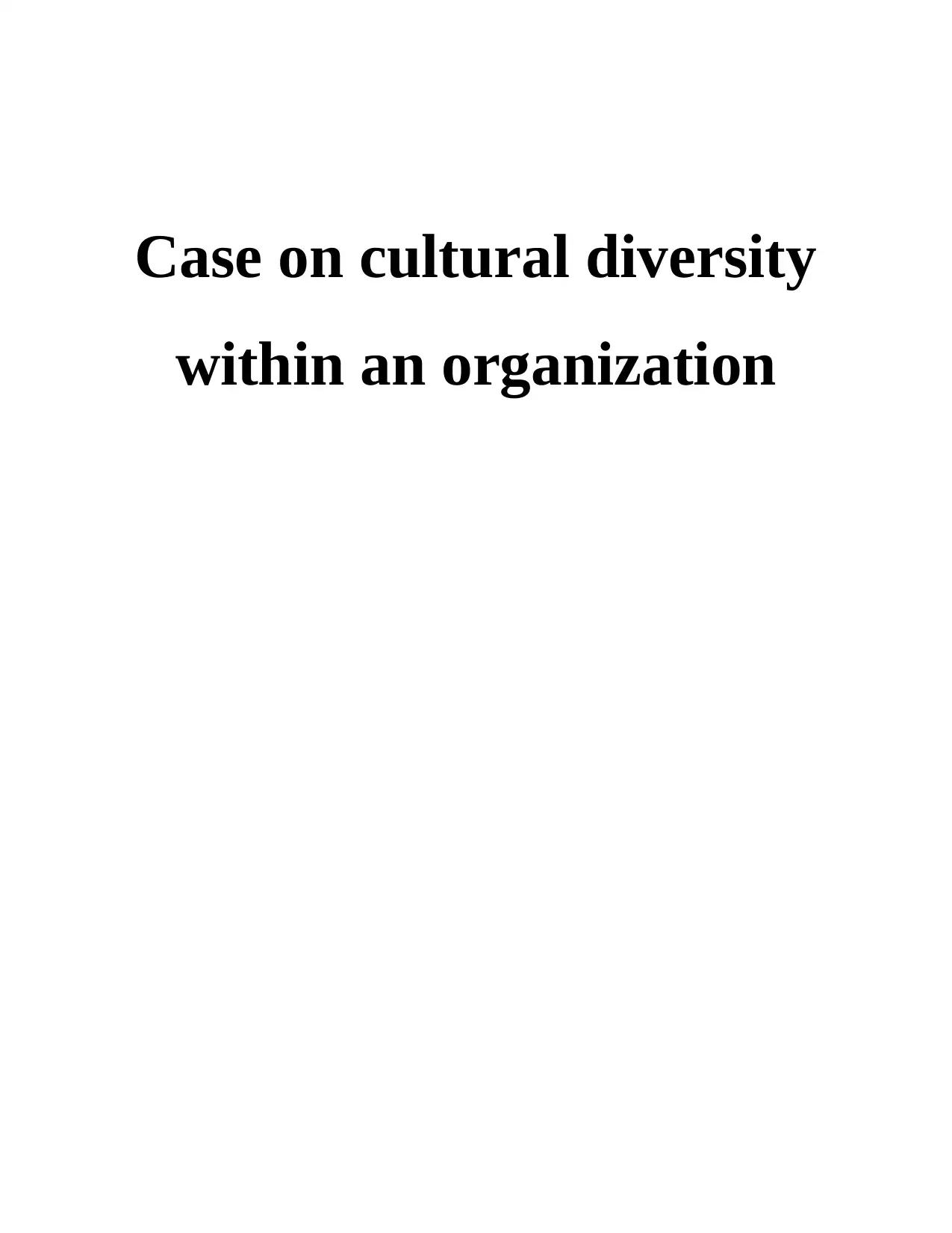
Case on cultural diversity
within an organization
within an organization
Paraphrase This Document
Need a fresh take? Get an instant paraphrase of this document with our AI Paraphraser
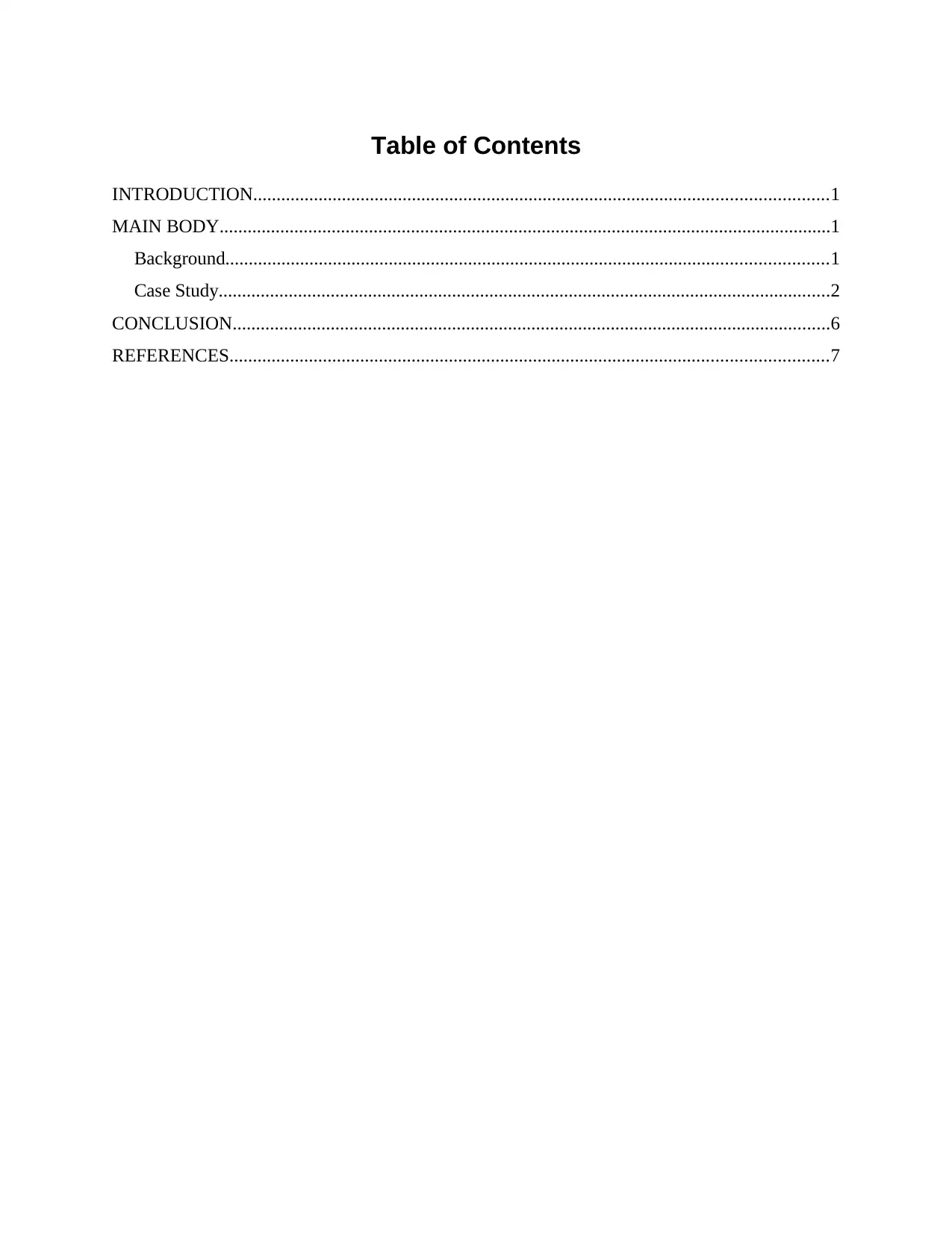
Table of Contents
INTRODUCTION...........................................................................................................................1
MAIN BODY...................................................................................................................................1
Background.................................................................................................................................1
Case Study...................................................................................................................................2
CONCLUSION................................................................................................................................6
REFERENCES................................................................................................................................7
INTRODUCTION...........................................................................................................................1
MAIN BODY...................................................................................................................................1
Background.................................................................................................................................1
Case Study...................................................................................................................................2
CONCLUSION................................................................................................................................6
REFERENCES................................................................................................................................7
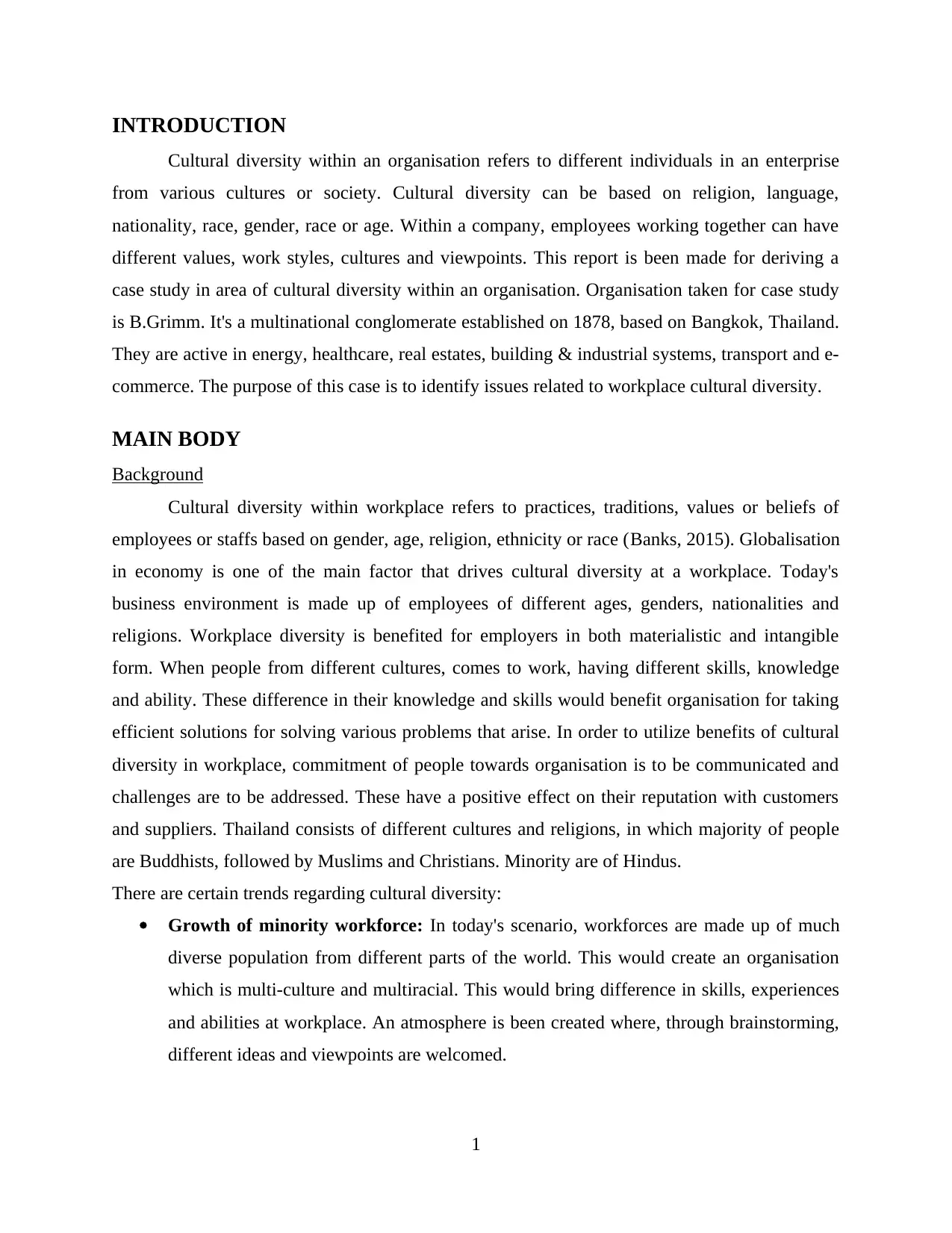
INTRODUCTION
Cultural diversity within an organisation refers to different individuals in an enterprise
from various cultures or society. Cultural diversity can be based on religion, language,
nationality, race, gender, race or age. Within a company, employees working together can have
different values, work styles, cultures and viewpoints. This report is been made for deriving a
case study in area of cultural diversity within an organisation. Organisation taken for case study
is B.Grimm. It's a multinational conglomerate established on 1878, based on Bangkok, Thailand.
They are active in energy, healthcare, real estates, building & industrial systems, transport and e-
commerce. The purpose of this case is to identify issues related to workplace cultural diversity.
MAIN BODY
Background
Cultural diversity within workplace refers to practices, traditions, values or beliefs of
employees or staffs based on gender, age, religion, ethnicity or race (Banks, 2015). Globalisation
in economy is one of the main factor that drives cultural diversity at a workplace. Today's
business environment is made up of employees of different ages, genders, nationalities and
religions. Workplace diversity is benefited for employers in both materialistic and intangible
form. When people from different cultures, comes to work, having different skills, knowledge
and ability. These difference in their knowledge and skills would benefit organisation for taking
efficient solutions for solving various problems that arise. In order to utilize benefits of cultural
diversity in workplace, commitment of people towards organisation is to be communicated and
challenges are to be addressed. These have a positive effect on their reputation with customers
and suppliers. Thailand consists of different cultures and religions, in which majority of people
are Buddhists, followed by Muslims and Christians. Minority are of Hindus.
There are certain trends regarding cultural diversity:
Growth of minority workforce: In today's scenario, workforces are made up of much
diverse population from different parts of the world. This would create an organisation
which is multi-culture and multiracial. This would bring difference in skills, experiences
and abilities at workplace. An atmosphere is been created where, through brainstorming,
different ideas and viewpoints are welcomed.
1
Cultural diversity within an organisation refers to different individuals in an enterprise
from various cultures or society. Cultural diversity can be based on religion, language,
nationality, race, gender, race or age. Within a company, employees working together can have
different values, work styles, cultures and viewpoints. This report is been made for deriving a
case study in area of cultural diversity within an organisation. Organisation taken for case study
is B.Grimm. It's a multinational conglomerate established on 1878, based on Bangkok, Thailand.
They are active in energy, healthcare, real estates, building & industrial systems, transport and e-
commerce. The purpose of this case is to identify issues related to workplace cultural diversity.
MAIN BODY
Background
Cultural diversity within workplace refers to practices, traditions, values or beliefs of
employees or staffs based on gender, age, religion, ethnicity or race (Banks, 2015). Globalisation
in economy is one of the main factor that drives cultural diversity at a workplace. Today's
business environment is made up of employees of different ages, genders, nationalities and
religions. Workplace diversity is benefited for employers in both materialistic and intangible
form. When people from different cultures, comes to work, having different skills, knowledge
and ability. These difference in their knowledge and skills would benefit organisation for taking
efficient solutions for solving various problems that arise. In order to utilize benefits of cultural
diversity in workplace, commitment of people towards organisation is to be communicated and
challenges are to be addressed. These have a positive effect on their reputation with customers
and suppliers. Thailand consists of different cultures and religions, in which majority of people
are Buddhists, followed by Muslims and Christians. Minority are of Hindus.
There are certain trends regarding cultural diversity:
Growth of minority workforce: In today's scenario, workforces are made up of much
diverse population from different parts of the world. This would create an organisation
which is multi-culture and multiracial. This would bring difference in skills, experiences
and abilities at workplace. An atmosphere is been created where, through brainstorming,
different ideas and viewpoints are welcomed.
1
⊘ This is a preview!⊘
Do you want full access?
Subscribe today to unlock all pages.

Trusted by 1+ million students worldwide
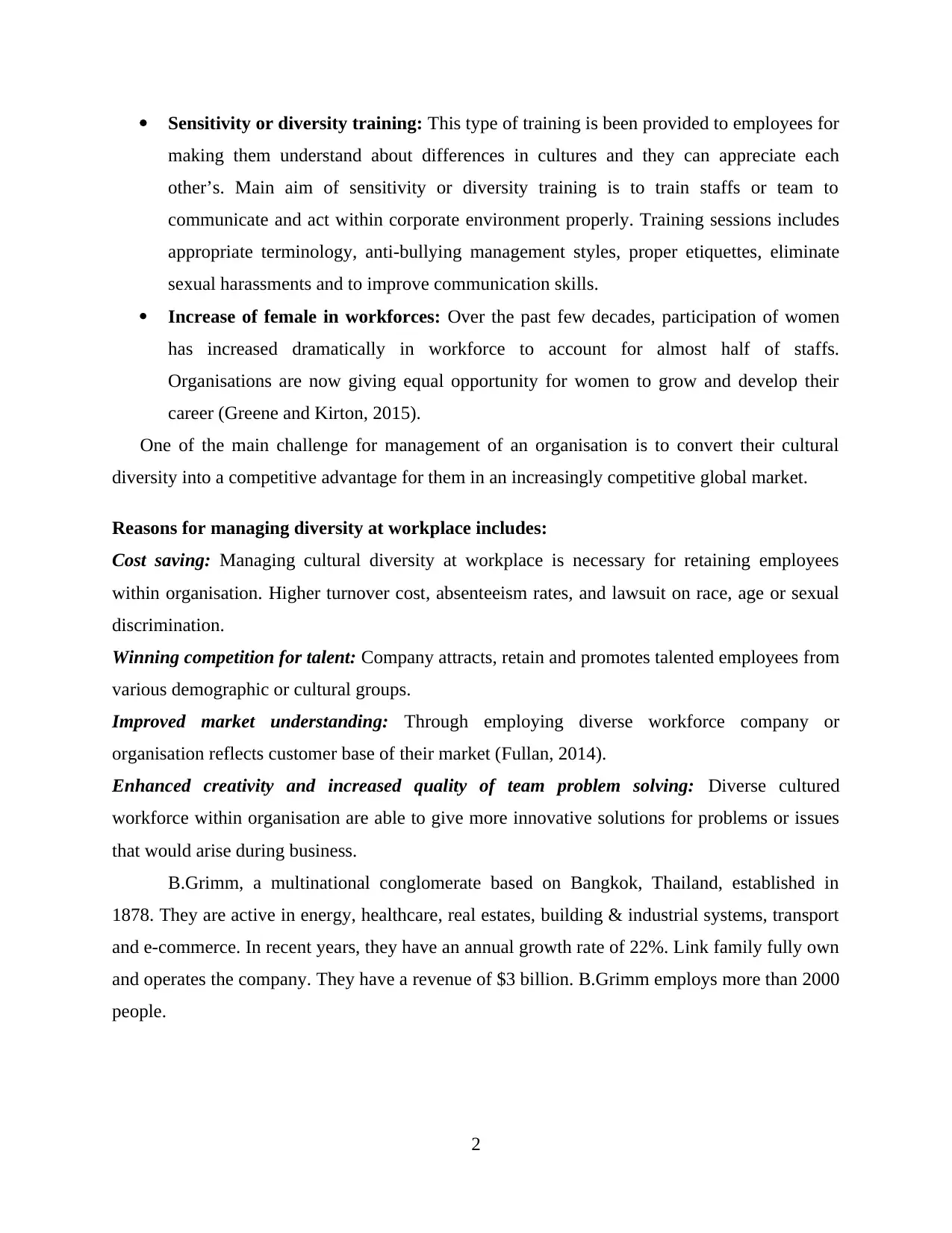
Sensitivity or diversity training: This type of training is been provided to employees for
making them understand about differences in cultures and they can appreciate each
other’s. Main aim of sensitivity or diversity training is to train staffs or team to
communicate and act within corporate environment properly. Training sessions includes
appropriate terminology, anti-bullying management styles, proper etiquettes, eliminate
sexual harassments and to improve communication skills.
Increase of female in workforces: Over the past few decades, participation of women
has increased dramatically in workforce to account for almost half of staffs.
Organisations are now giving equal opportunity for women to grow and develop their
career (Greene and Kirton, 2015).
One of the main challenge for management of an organisation is to convert their cultural
diversity into a competitive advantage for them in an increasingly competitive global market.
Reasons for managing diversity at workplace includes:
Cost saving: Managing cultural diversity at workplace is necessary for retaining employees
within organisation. Higher turnover cost, absenteeism rates, and lawsuit on race, age or sexual
discrimination.
Winning competition for talent: Company attracts, retain and promotes talented employees from
various demographic or cultural groups.
Improved market understanding: Through employing diverse workforce company or
organisation reflects customer base of their market (Fullan, 2014).
Enhanced creativity and increased quality of team problem solving: Diverse cultured
workforce within organisation are able to give more innovative solutions for problems or issues
that would arise during business.
B.Grimm, a multinational conglomerate based on Bangkok, Thailand, established in
1878. They are active in energy, healthcare, real estates, building & industrial systems, transport
and e-commerce. In recent years, they have an annual growth rate of 22%. Link family fully own
and operates the company. They have a revenue of $3 billion. B.Grimm employs more than 2000
people.
2
making them understand about differences in cultures and they can appreciate each
other’s. Main aim of sensitivity or diversity training is to train staffs or team to
communicate and act within corporate environment properly. Training sessions includes
appropriate terminology, anti-bullying management styles, proper etiquettes, eliminate
sexual harassments and to improve communication skills.
Increase of female in workforces: Over the past few decades, participation of women
has increased dramatically in workforce to account for almost half of staffs.
Organisations are now giving equal opportunity for women to grow and develop their
career (Greene and Kirton, 2015).
One of the main challenge for management of an organisation is to convert their cultural
diversity into a competitive advantage for them in an increasingly competitive global market.
Reasons for managing diversity at workplace includes:
Cost saving: Managing cultural diversity at workplace is necessary for retaining employees
within organisation. Higher turnover cost, absenteeism rates, and lawsuit on race, age or sexual
discrimination.
Winning competition for talent: Company attracts, retain and promotes talented employees from
various demographic or cultural groups.
Improved market understanding: Through employing diverse workforce company or
organisation reflects customer base of their market (Fullan, 2014).
Enhanced creativity and increased quality of team problem solving: Diverse cultured
workforce within organisation are able to give more innovative solutions for problems or issues
that would arise during business.
B.Grimm, a multinational conglomerate based on Bangkok, Thailand, established in
1878. They are active in energy, healthcare, real estates, building & industrial systems, transport
and e-commerce. In recent years, they have an annual growth rate of 22%. Link family fully own
and operates the company. They have a revenue of $3 billion. B.Grimm employs more than 2000
people.
2
Paraphrase This Document
Need a fresh take? Get an instant paraphrase of this document with our AI Paraphraser
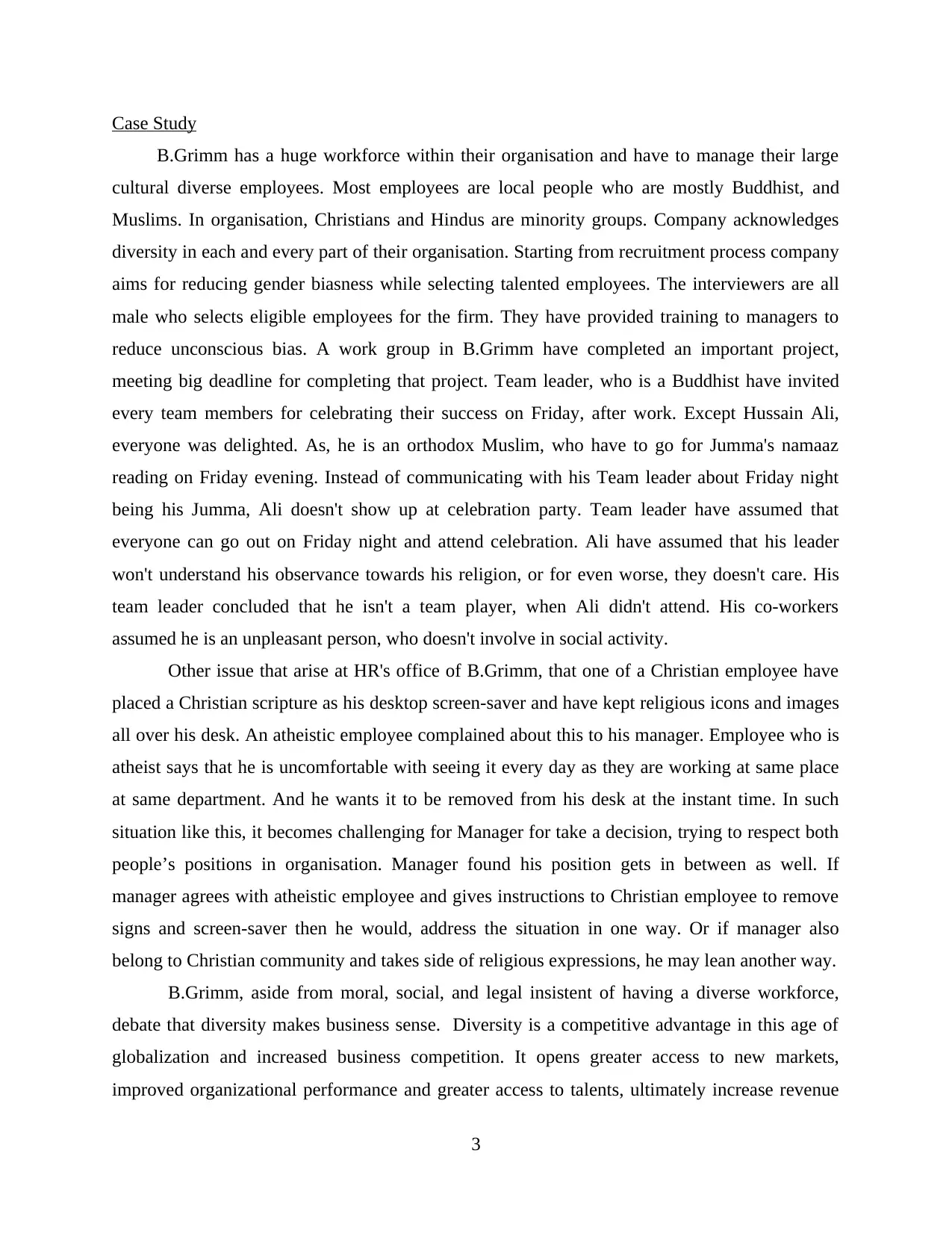
Case Study
B.Grimm has a huge workforce within their organisation and have to manage their large
cultural diverse employees. Most employees are local people who are mostly Buddhist, and
Muslims. In organisation, Christians and Hindus are minority groups. Company acknowledges
diversity in each and every part of their organisation. Starting from recruitment process company
aims for reducing gender biasness while selecting talented employees. The interviewers are all
male who selects eligible employees for the firm. They have provided training to managers to
reduce unconscious bias. A work group in B.Grimm have completed an important project,
meeting big deadline for completing that project. Team leader, who is a Buddhist have invited
every team members for celebrating their success on Friday, after work. Except Hussain Ali,
everyone was delighted. As, he is an orthodox Muslim, who have to go for Jumma's namaaz
reading on Friday evening. Instead of communicating with his Team leader about Friday night
being his Jumma, Ali doesn't show up at celebration party. Team leader have assumed that
everyone can go out on Friday night and attend celebration. Ali have assumed that his leader
won't understand his observance towards his religion, or for even worse, they doesn't care. His
team leader concluded that he isn't a team player, when Ali didn't attend. His co-workers
assumed he is an unpleasant person, who doesn't involve in social activity.
Other issue that arise at HR's office of B.Grimm, that one of a Christian employee have
placed a Christian scripture as his desktop screen-saver and have kept religious icons and images
all over his desk. An atheistic employee complained about this to his manager. Employee who is
atheist says that he is uncomfortable with seeing it every day as they are working at same place
at same department. And he wants it to be removed from his desk at the instant time. In such
situation like this, it becomes challenging for Manager for take a decision, trying to respect both
people’s positions in organisation. Manager found his position gets in between as well. If
manager agrees with atheistic employee and gives instructions to Christian employee to remove
signs and screen-saver then he would, address the situation in one way. Or if manager also
belong to Christian community and takes side of religious expressions, he may lean another way.
B.Grimm, aside from moral, social, and legal insistent of having a diverse workforce,
debate that diversity makes business sense. Diversity is a competitive advantage in this age of
globalization and increased business competition. It opens greater access to new markets,
improved organizational performance and greater access to talents, ultimately increase revenue
3
B.Grimm has a huge workforce within their organisation and have to manage their large
cultural diverse employees. Most employees are local people who are mostly Buddhist, and
Muslims. In organisation, Christians and Hindus are minority groups. Company acknowledges
diversity in each and every part of their organisation. Starting from recruitment process company
aims for reducing gender biasness while selecting talented employees. The interviewers are all
male who selects eligible employees for the firm. They have provided training to managers to
reduce unconscious bias. A work group in B.Grimm have completed an important project,
meeting big deadline for completing that project. Team leader, who is a Buddhist have invited
every team members for celebrating their success on Friday, after work. Except Hussain Ali,
everyone was delighted. As, he is an orthodox Muslim, who have to go for Jumma's namaaz
reading on Friday evening. Instead of communicating with his Team leader about Friday night
being his Jumma, Ali doesn't show up at celebration party. Team leader have assumed that
everyone can go out on Friday night and attend celebration. Ali have assumed that his leader
won't understand his observance towards his religion, or for even worse, they doesn't care. His
team leader concluded that he isn't a team player, when Ali didn't attend. His co-workers
assumed he is an unpleasant person, who doesn't involve in social activity.
Other issue that arise at HR's office of B.Grimm, that one of a Christian employee have
placed a Christian scripture as his desktop screen-saver and have kept religious icons and images
all over his desk. An atheistic employee complained about this to his manager. Employee who is
atheist says that he is uncomfortable with seeing it every day as they are working at same place
at same department. And he wants it to be removed from his desk at the instant time. In such
situation like this, it becomes challenging for Manager for take a decision, trying to respect both
people’s positions in organisation. Manager found his position gets in between as well. If
manager agrees with atheistic employee and gives instructions to Christian employee to remove
signs and screen-saver then he would, address the situation in one way. Or if manager also
belong to Christian community and takes side of religious expressions, he may lean another way.
B.Grimm, aside from moral, social, and legal insistent of having a diverse workforce,
debate that diversity makes business sense. Diversity is a competitive advantage in this age of
globalization and increased business competition. It opens greater access to new markets,
improved organizational performance and greater access to talents, ultimately increase revenue
3
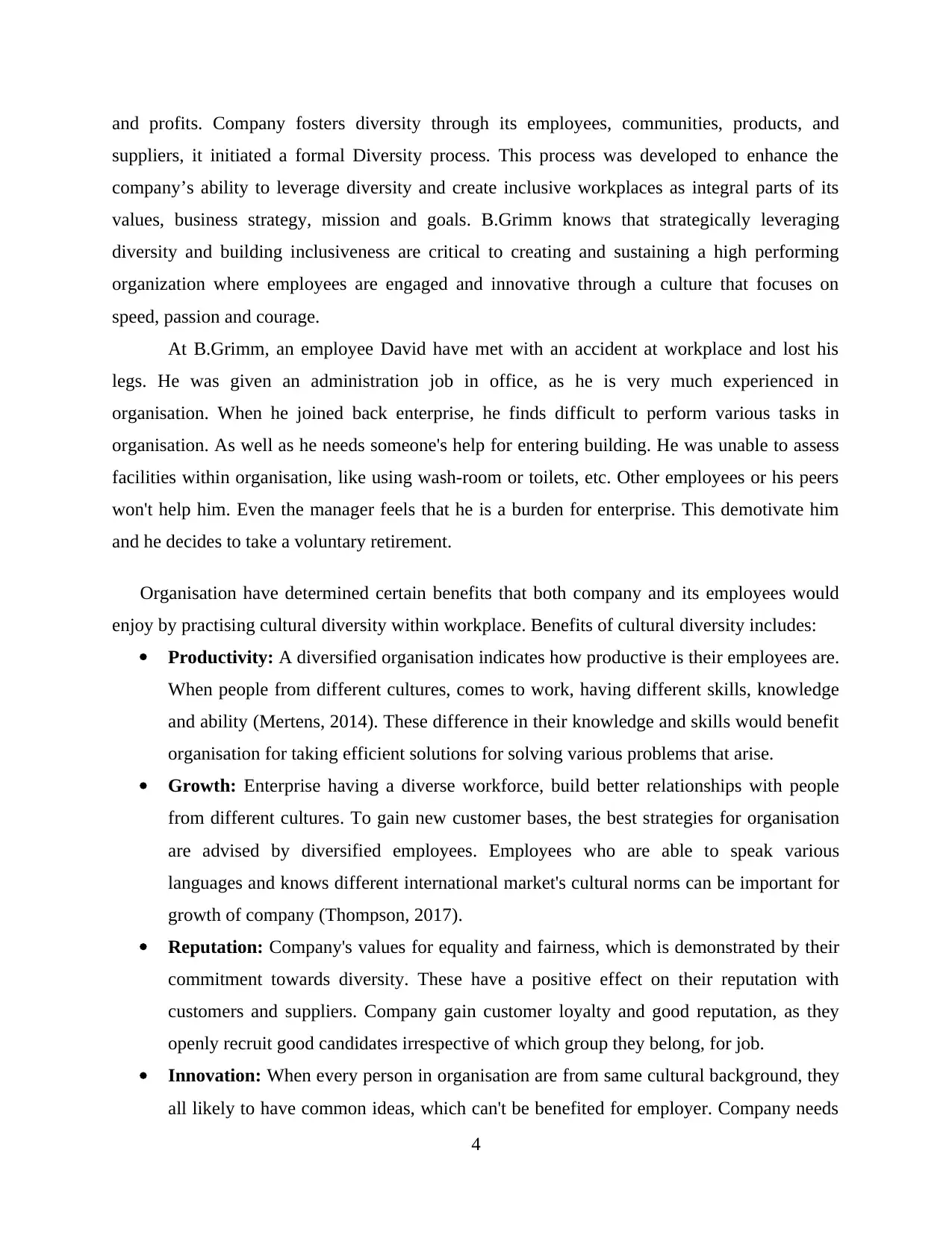
and profits. Company fosters diversity through its employees, communities, products, and
suppliers, it initiated a formal Diversity process. This process was developed to enhance the
company’s ability to leverage diversity and create inclusive workplaces as integral parts of its
values, business strategy, mission and goals. B.Grimm knows that strategically leveraging
diversity and building inclusiveness are critical to creating and sustaining a high performing
organization where employees are engaged and innovative through a culture that focuses on
speed, passion and courage.
At B.Grimm, an employee David have met with an accident at workplace and lost his
legs. He was given an administration job in office, as he is very much experienced in
organisation. When he joined back enterprise, he finds difficult to perform various tasks in
organisation. As well as he needs someone's help for entering building. He was unable to assess
facilities within organisation, like using wash-room or toilets, etc. Other employees or his peers
won't help him. Even the manager feels that he is a burden for enterprise. This demotivate him
and he decides to take a voluntary retirement.
Organisation have determined certain benefits that both company and its employees would
enjoy by practising cultural diversity within workplace. Benefits of cultural diversity includes:
Productivity: A diversified organisation indicates how productive is their employees are.
When people from different cultures, comes to work, having different skills, knowledge
and ability (Mertens, 2014). These difference in their knowledge and skills would benefit
organisation for taking efficient solutions for solving various problems that arise.
Growth: Enterprise having a diverse workforce, build better relationships with people
from different cultures. To gain new customer bases, the best strategies for organisation
are advised by diversified employees. Employees who are able to speak various
languages and knows different international market's cultural norms can be important for
growth of company (Thompson, 2017).
Reputation: Company's values for equality and fairness, which is demonstrated by their
commitment towards diversity. These have a positive effect on their reputation with
customers and suppliers. Company gain customer loyalty and good reputation, as they
openly recruit good candidates irrespective of which group they belong, for job.
Innovation: When every person in organisation are from same cultural background, they
all likely to have common ideas, which can't be benefited for employer. Company needs
4
suppliers, it initiated a formal Diversity process. This process was developed to enhance the
company’s ability to leverage diversity and create inclusive workplaces as integral parts of its
values, business strategy, mission and goals. B.Grimm knows that strategically leveraging
diversity and building inclusiveness are critical to creating and sustaining a high performing
organization where employees are engaged and innovative through a culture that focuses on
speed, passion and courage.
At B.Grimm, an employee David have met with an accident at workplace and lost his
legs. He was given an administration job in office, as he is very much experienced in
organisation. When he joined back enterprise, he finds difficult to perform various tasks in
organisation. As well as he needs someone's help for entering building. He was unable to assess
facilities within organisation, like using wash-room or toilets, etc. Other employees or his peers
won't help him. Even the manager feels that he is a burden for enterprise. This demotivate him
and he decides to take a voluntary retirement.
Organisation have determined certain benefits that both company and its employees would
enjoy by practising cultural diversity within workplace. Benefits of cultural diversity includes:
Productivity: A diversified organisation indicates how productive is their employees are.
When people from different cultures, comes to work, having different skills, knowledge
and ability (Mertens, 2014). These difference in their knowledge and skills would benefit
organisation for taking efficient solutions for solving various problems that arise.
Growth: Enterprise having a diverse workforce, build better relationships with people
from different cultures. To gain new customer bases, the best strategies for organisation
are advised by diversified employees. Employees who are able to speak various
languages and knows different international market's cultural norms can be important for
growth of company (Thompson, 2017).
Reputation: Company's values for equality and fairness, which is demonstrated by their
commitment towards diversity. These have a positive effect on their reputation with
customers and suppliers. Company gain customer loyalty and good reputation, as they
openly recruit good candidates irrespective of which group they belong, for job.
Innovation: When every person in organisation are from same cultural background, they
all likely to have common ideas, which can't be benefited for employer. Company needs
4
⊘ This is a preview!⊘
Do you want full access?
Subscribe today to unlock all pages.

Trusted by 1+ million students worldwide
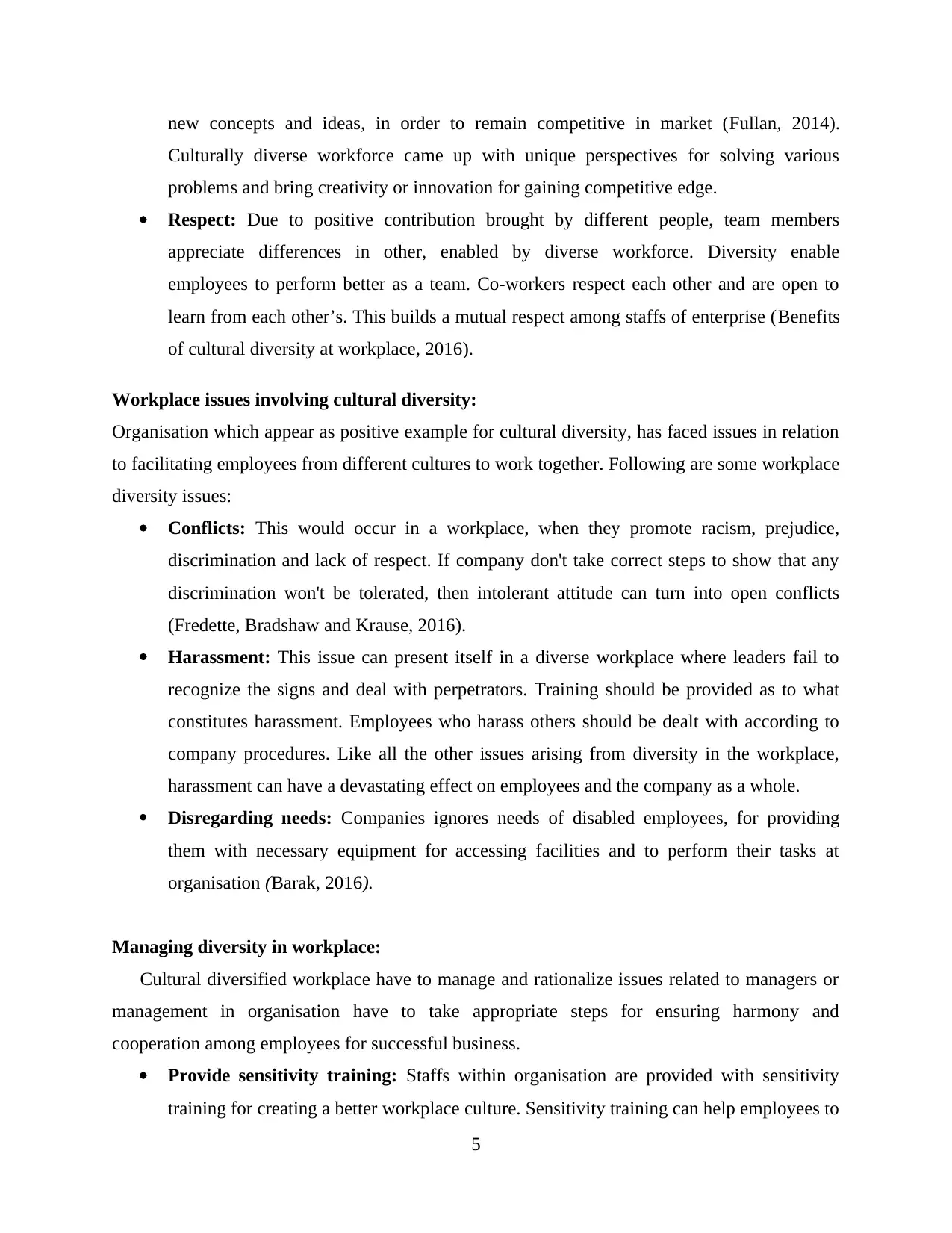
new concepts and ideas, in order to remain competitive in market (Fullan, 2014).
Culturally diverse workforce came up with unique perspectives for solving various
problems and bring creativity or innovation for gaining competitive edge.
Respect: Due to positive contribution brought by different people, team members
appreciate differences in other, enabled by diverse workforce. Diversity enable
employees to perform better as a team. Co-workers respect each other and are open to
learn from each other’s. This builds a mutual respect among staffs of enterprise (Benefits
of cultural diversity at workplace, 2016).
Workplace issues involving cultural diversity:
Organisation which appear as positive example for cultural diversity, has faced issues in relation
to facilitating employees from different cultures to work together. Following are some workplace
diversity issues:
Conflicts: This would occur in a workplace, when they promote racism, prejudice,
discrimination and lack of respect. If company don't take correct steps to show that any
discrimination won't be tolerated, then intolerant attitude can turn into open conflicts
(Fredette, Bradshaw and Krause, 2016).
Harassment: This issue can present itself in a diverse workplace where leaders fail to
recognize the signs and deal with perpetrators. Training should be provided as to what
constitutes harassment. Employees who harass others should be dealt with according to
company procedures. Like all the other issues arising from diversity in the workplace,
harassment can have a devastating effect on employees and the company as a whole.
Disregarding needs: Companies ignores needs of disabled employees, for providing
them with necessary equipment for accessing facilities and to perform their tasks at
organisation (Barak, 2016).
Managing diversity in workplace:
Cultural diversified workplace have to manage and rationalize issues related to managers or
management in organisation have to take appropriate steps for ensuring harmony and
cooperation among employees for successful business.
Provide sensitivity training: Staffs within organisation are provided with sensitivity
training for creating a better workplace culture. Sensitivity training can help employees to
5
Culturally diverse workforce came up with unique perspectives for solving various
problems and bring creativity or innovation for gaining competitive edge.
Respect: Due to positive contribution brought by different people, team members
appreciate differences in other, enabled by diverse workforce. Diversity enable
employees to perform better as a team. Co-workers respect each other and are open to
learn from each other’s. This builds a mutual respect among staffs of enterprise (Benefits
of cultural diversity at workplace, 2016).
Workplace issues involving cultural diversity:
Organisation which appear as positive example for cultural diversity, has faced issues in relation
to facilitating employees from different cultures to work together. Following are some workplace
diversity issues:
Conflicts: This would occur in a workplace, when they promote racism, prejudice,
discrimination and lack of respect. If company don't take correct steps to show that any
discrimination won't be tolerated, then intolerant attitude can turn into open conflicts
(Fredette, Bradshaw and Krause, 2016).
Harassment: This issue can present itself in a diverse workplace where leaders fail to
recognize the signs and deal with perpetrators. Training should be provided as to what
constitutes harassment. Employees who harass others should be dealt with according to
company procedures. Like all the other issues arising from diversity in the workplace,
harassment can have a devastating effect on employees and the company as a whole.
Disregarding needs: Companies ignores needs of disabled employees, for providing
them with necessary equipment for accessing facilities and to perform their tasks at
organisation (Barak, 2016).
Managing diversity in workplace:
Cultural diversified workplace have to manage and rationalize issues related to managers or
management in organisation have to take appropriate steps for ensuring harmony and
cooperation among employees for successful business.
Provide sensitivity training: Staffs within organisation are provided with sensitivity
training for creating a better workplace culture. Sensitivity training can help employees to
5
Paraphrase This Document
Need a fresh take? Get an instant paraphrase of this document with our AI Paraphraser
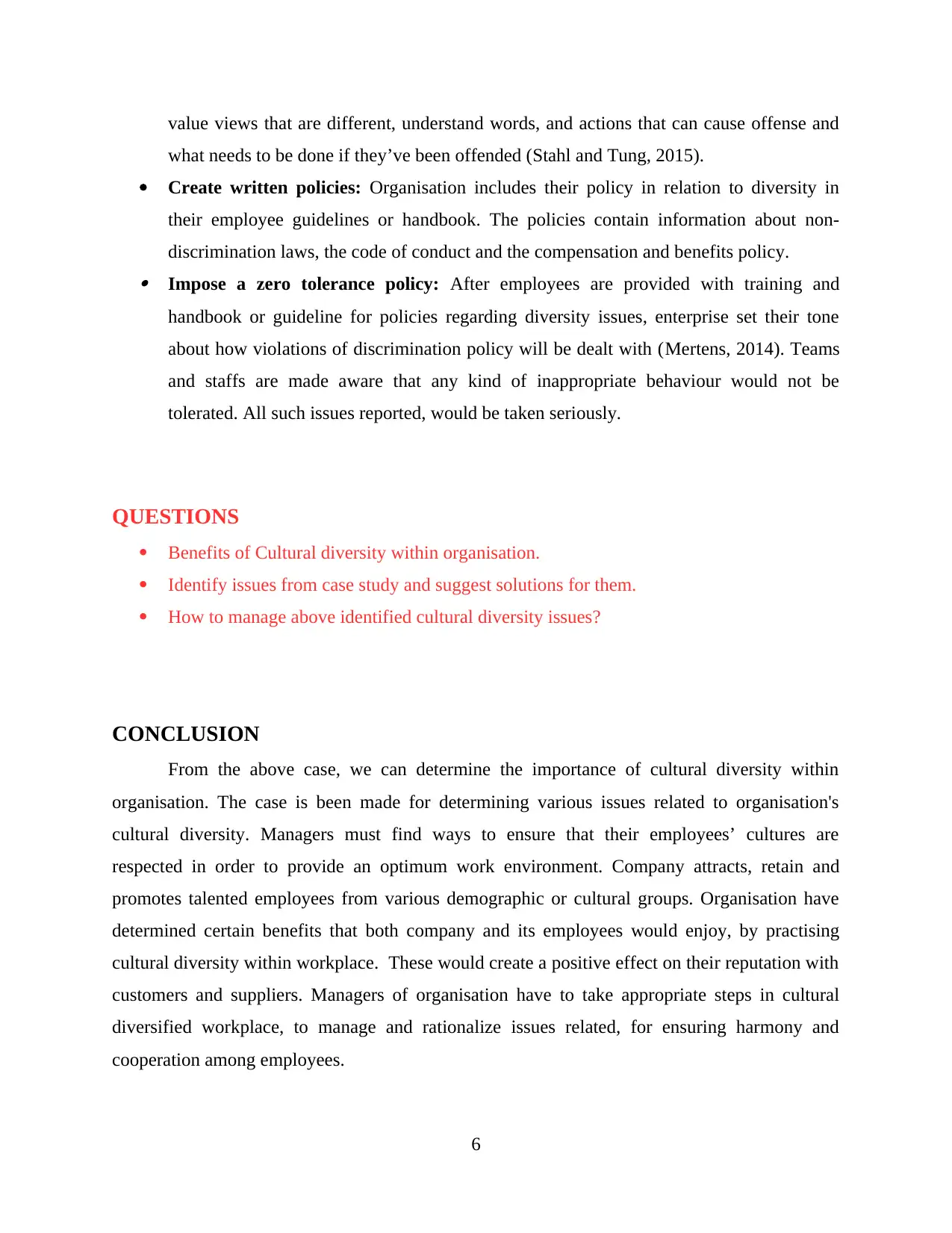
value views that are different, understand words, and actions that can cause offense and
what needs to be done if they’ve been offended (Stahl and Tung, 2015).
Create written policies: Organisation includes their policy in relation to diversity in
their employee guidelines or handbook. The policies contain information about non-
discrimination laws, the code of conduct and the compensation and benefits policy. Impose a zero tolerance policy: After employees are provided with training and
handbook or guideline for policies regarding diversity issues, enterprise set their tone
about how violations of discrimination policy will be dealt with (Mertens, 2014). Teams
and staffs are made aware that any kind of inappropriate behaviour would not be
tolerated. All such issues reported, would be taken seriously.
QUESTIONS
Benefits of Cultural diversity within organisation.
Identify issues from case study and suggest solutions for them.
How to manage above identified cultural diversity issues?
CONCLUSION
From the above case, we can determine the importance of cultural diversity within
organisation. The case is been made for determining various issues related to organisation's
cultural diversity. Managers must find ways to ensure that their employees’ cultures are
respected in order to provide an optimum work environment. Company attracts, retain and
promotes talented employees from various demographic or cultural groups. Organisation have
determined certain benefits that both company and its employees would enjoy, by practising
cultural diversity within workplace. These would create a positive effect on their reputation with
customers and suppliers. Managers of organisation have to take appropriate steps in cultural
diversified workplace, to manage and rationalize issues related, for ensuring harmony and
cooperation among employees.
6
what needs to be done if they’ve been offended (Stahl and Tung, 2015).
Create written policies: Organisation includes their policy in relation to diversity in
their employee guidelines or handbook. The policies contain information about non-
discrimination laws, the code of conduct and the compensation and benefits policy. Impose a zero tolerance policy: After employees are provided with training and
handbook or guideline for policies regarding diversity issues, enterprise set their tone
about how violations of discrimination policy will be dealt with (Mertens, 2014). Teams
and staffs are made aware that any kind of inappropriate behaviour would not be
tolerated. All such issues reported, would be taken seriously.
QUESTIONS
Benefits of Cultural diversity within organisation.
Identify issues from case study and suggest solutions for them.
How to manage above identified cultural diversity issues?
CONCLUSION
From the above case, we can determine the importance of cultural diversity within
organisation. The case is been made for determining various issues related to organisation's
cultural diversity. Managers must find ways to ensure that their employees’ cultures are
respected in order to provide an optimum work environment. Company attracts, retain and
promotes talented employees from various demographic or cultural groups. Organisation have
determined certain benefits that both company and its employees would enjoy, by practising
cultural diversity within workplace. These would create a positive effect on their reputation with
customers and suppliers. Managers of organisation have to take appropriate steps in cultural
diversified workplace, to manage and rationalize issues related, for ensuring harmony and
cooperation among employees.
6
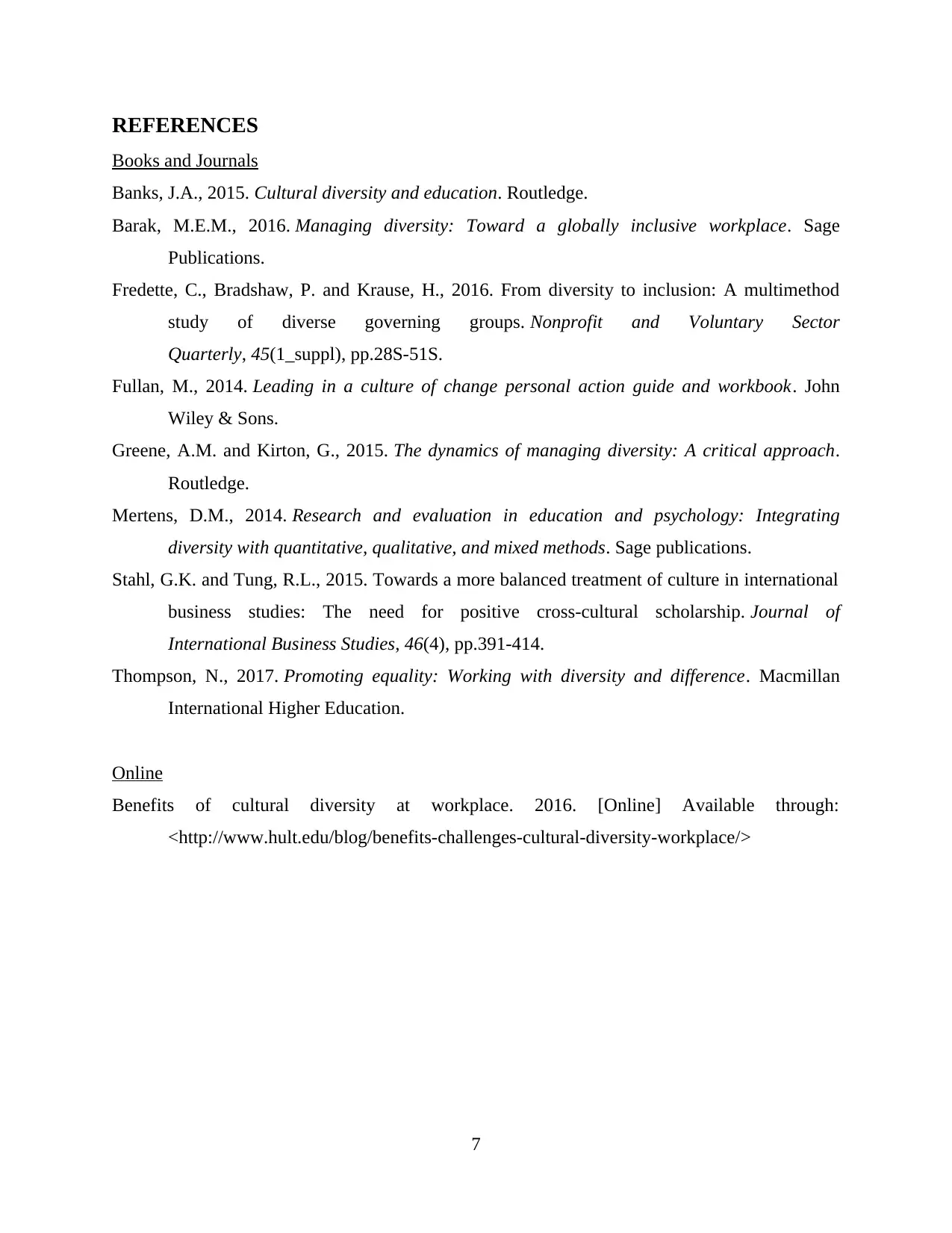
REFERENCES
Books and Journals
Banks, J.A., 2015. Cultural diversity and education. Routledge.
Barak, M.E.M., 2016. Managing diversity: Toward a globally inclusive workplace. Sage
Publications.
Fredette, C., Bradshaw, P. and Krause, H., 2016. From diversity to inclusion: A multimethod
study of diverse governing groups. Nonprofit and Voluntary Sector
Quarterly, 45(1_suppl), pp.28S-51S.
Fullan, M., 2014. Leading in a culture of change personal action guide and workbook. John
Wiley & Sons.
Greene, A.M. and Kirton, G., 2015. The dynamics of managing diversity: A critical approach.
Routledge.
Mertens, D.M., 2014. Research and evaluation in education and psychology: Integrating
diversity with quantitative, qualitative, and mixed methods. Sage publications.
Stahl, G.K. and Tung, R.L., 2015. Towards a more balanced treatment of culture in international
business studies: The need for positive cross-cultural scholarship. Journal of
International Business Studies, 46(4), pp.391-414.
Thompson, N., 2017. Promoting equality: Working with diversity and difference. Macmillan
International Higher Education.
Online
Benefits of cultural diversity at workplace. 2016. [Online] Available through:
<http://www.hult.edu/blog/benefits-challenges-cultural-diversity-workplace/>
7
Books and Journals
Banks, J.A., 2015. Cultural diversity and education. Routledge.
Barak, M.E.M., 2016. Managing diversity: Toward a globally inclusive workplace. Sage
Publications.
Fredette, C., Bradshaw, P. and Krause, H., 2016. From diversity to inclusion: A multimethod
study of diverse governing groups. Nonprofit and Voluntary Sector
Quarterly, 45(1_suppl), pp.28S-51S.
Fullan, M., 2014. Leading in a culture of change personal action guide and workbook. John
Wiley & Sons.
Greene, A.M. and Kirton, G., 2015. The dynamics of managing diversity: A critical approach.
Routledge.
Mertens, D.M., 2014. Research and evaluation in education and psychology: Integrating
diversity with quantitative, qualitative, and mixed methods. Sage publications.
Stahl, G.K. and Tung, R.L., 2015. Towards a more balanced treatment of culture in international
business studies: The need for positive cross-cultural scholarship. Journal of
International Business Studies, 46(4), pp.391-414.
Thompson, N., 2017. Promoting equality: Working with diversity and difference. Macmillan
International Higher Education.
Online
Benefits of cultural diversity at workplace. 2016. [Online] Available through:
<http://www.hult.edu/blog/benefits-challenges-cultural-diversity-workplace/>
7
⊘ This is a preview!⊘
Do you want full access?
Subscribe today to unlock all pages.

Trusted by 1+ million students worldwide
1 out of 9
Related Documents
Your All-in-One AI-Powered Toolkit for Academic Success.
+13062052269
info@desklib.com
Available 24*7 on WhatsApp / Email
![[object Object]](/_next/static/media/star-bottom.7253800d.svg)
Unlock your academic potential
Copyright © 2020–2025 A2Z Services. All Rights Reserved. Developed and managed by ZUCOL.





